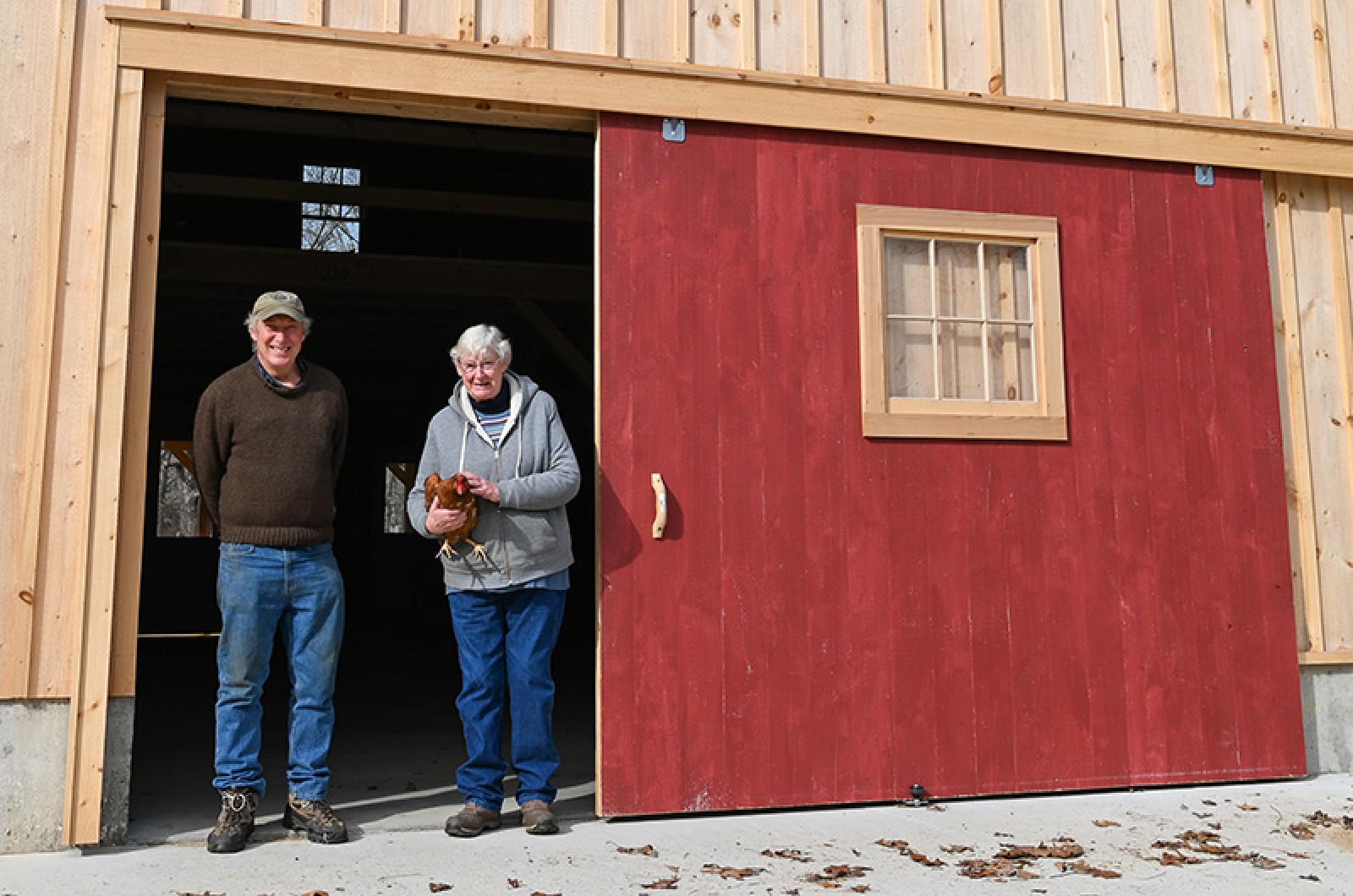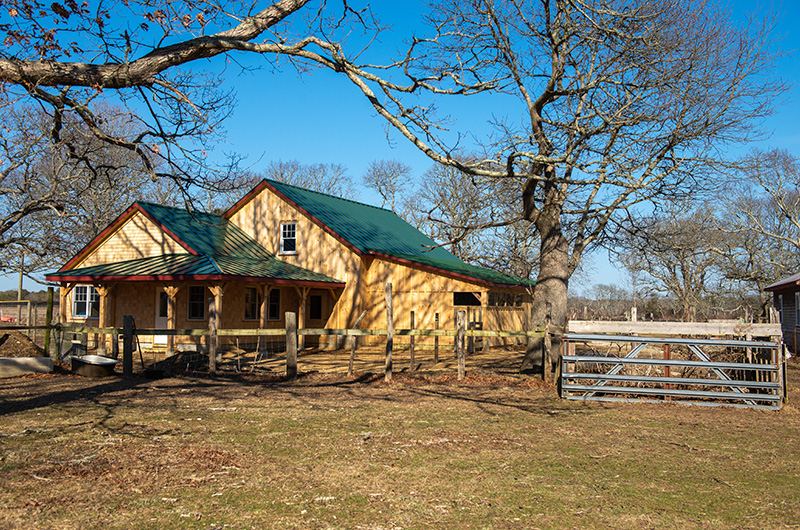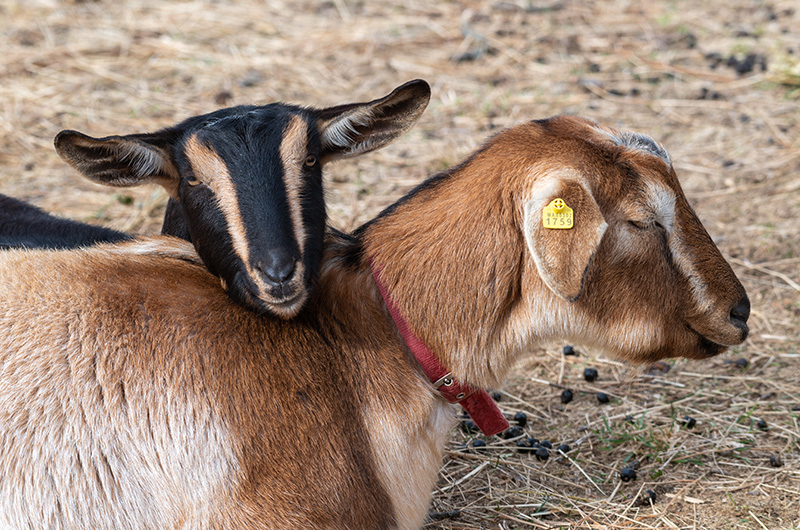On March 19, 2019, a pre-dawn fire at Flat Point Farm in West Tisbury leveled the historic barn to its foundation and claimed the lives of 90 animals. A year later, as the first days of spring approach, a new flock of eight bluefaced leicester-montadale sheep have been introduced, along with new hope for the future of the farm.
“There is a rebirth,” said Arnie Fischer Jr., despite this being the first year in his memory that the bleat of lambs has not ushered in the growing season. “Normally the big thing in the spring is the crop of lambs. That will happen next year.”
On Monday, signs of new life were in evidence all through the open meadows that sprawl along the banks of Tisbury Great Pond. Asparagus heads were beginning to sprout from their bed. Winter garlic was approaching harvest. Hoof prints were tracked across the newly poured concrete foundation. And the smell of wet hay hung in the air with the dust of freshly sawed timbers.
“Right now we’re just planting, ordering seeds . . . and I’m going to start tilling the field soon,” said Lydia Fischer, Arnie’s cousin, who started growing vegetables on a quarter acre plot of Flat Point Farm last year. “It used to be a family tradition this time of year to go over and see the lambs that were just born . . . What happened to the barn, to the animals, was so tragic. But it really showed how special the whole community is, the way everyone was able to gather in support.”
On the final day of winter last year, a neighbor up early to catch a 6 a.m. ferry called the fire department to report crackling sounds coming from beyond the tree-line at Flat Point Farm. When the fire department arrived nothing but ash remained of the barn and five other smaller chicken coops and sheds.
The cause was later determined to be a heat lamp, Mr. Fischer said. No people were injured in the blaze, but the lives of 22 lambs, 12 sheep, two beef cattle and 50 chickens were claimed, along with the 80 year-old wooden structure that was a capsule of the family’s history.
The sheep lost in the fire were part of a lineage that could be traced back to before the old barn was raised in 1939, said Eleanor Neubert, who is a part owner of the farm along with her brother Arnie Fischer Jr.
“A year later, the worst is still thinking about the animals that perished,” Ms. Neubert said. “The old barn and all the memories, we still have those.”
Some of those memories include how, in the days following the fire, the Island community responded with an outpouring of support. Farmers organized multiple deliveries of hay and feed for the surviving animals. Others launched a Go Fund Me campaign that quickly raised over $120,000. And the Agricultural Hall hosted a benefit potluck dinner and concert in April.
The Fischer family held weekly barn meetings with other members of the community who volunteered their services. The old barn was originally built as a dairy barn, but as the family has moved away from cattle in recent years, they saw an opportunity to rebuild the barn to the scale of their sheep operation.
Flat Point Farm neighbor Peter Rodegast, who witnessed the blaze from his bedroom window, offered that morning to help draft a new design for the barn.
“The old barn was made for cattle. . . it had a gambrel roof and open space,” he said. “This one was designed around the needs for their farming: hay storage, sheep shelter, egg processing and selling, vegetable seeding.”
Kevin Cusack, the contractor for the project, hired an eight-man Amish crew from Lancaster, Pa. to raise the post and beams of the new barn. Their work was completed in just three days last October.
“They left on Sunday night at midnight with a tractor trailer truck of parts and pieces, and drove all night from Pennsylvania, arriving at sunrise on Monday,” Mr. Rodegast said. “They were only here for three days . . . It was amazing to see how fast they put up those pre-cut timbers.”
After the Amish crew raised the frame, Jim Creedon, who has been a carpenter on the farm for decades, and many other volunteers, completed the final touches. They installed windows, electrical wiring, a sliding barn door, sheet metal to finish the roof and poured the fresh slab of concrete foundation.
“A year ago, I never imagined we would have had the barn up by spring,” Mr. Neubert said. “Instead, we had a new barn by winter.”
There is still work left to be completed, Mr. Fischer said, gesturing to the roof, where he hopes to build a cupola and install solar panels. And there is still a glaring lack of clutter, the staple of any traditional barn.
“After 80 years, the old barn was filled to the brim with stuff that was going to be used one day,” Mr. Fischer said. “Let it be simple, uncluttered for the moment. We’re still working out where things are going to go.”
He pulled out an aluminum grain scoop from a newly built wooden bin, one of the few tools remaining that connect the current three generation of farmers to generations past. The fire had blackened the head and knotted the handle. It wasn’t necessarily valuable, he said, but he couldn’t come to part with it.
Come harvest season, Mr. Fischer said it will be business as usual at the farm. Goat milk soaps made by his daughter Emily Fischer, vegetables grown by Lydia Fischer and woolen products dyed and crafted by his wife Christa Fischer will be sold at farmers’ markets and fairs across the Island.
“I want people to know, we would have rebuilt but not in such a spectacular way,” Mr. Fischer said. “We appreciate the love and support of the community, and feel like we have done something here worthy of their generosity. Everybody should feel like they have a piece of this.”
On Monday, a tawny and white Hereford calf, born in July, the first animal born on the farm since the fire, chewed hay behind a charred, wooden fence post, marking the outermost boundary of the blaze.
Mr. Fischer pointed to the calf’s mother, the only animal on the farm to witness the fire.
“She’s the only one that can tell the story,” he said.











Comments (10)
Comments
Comment policy »